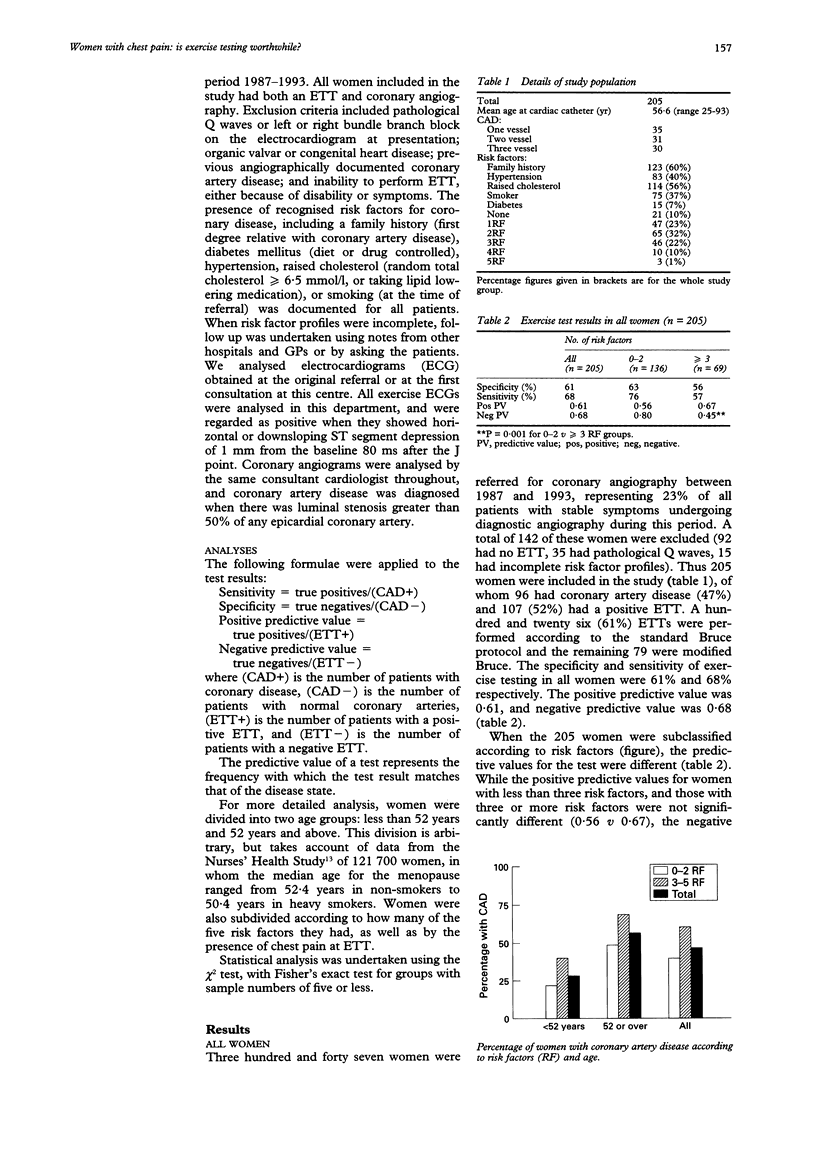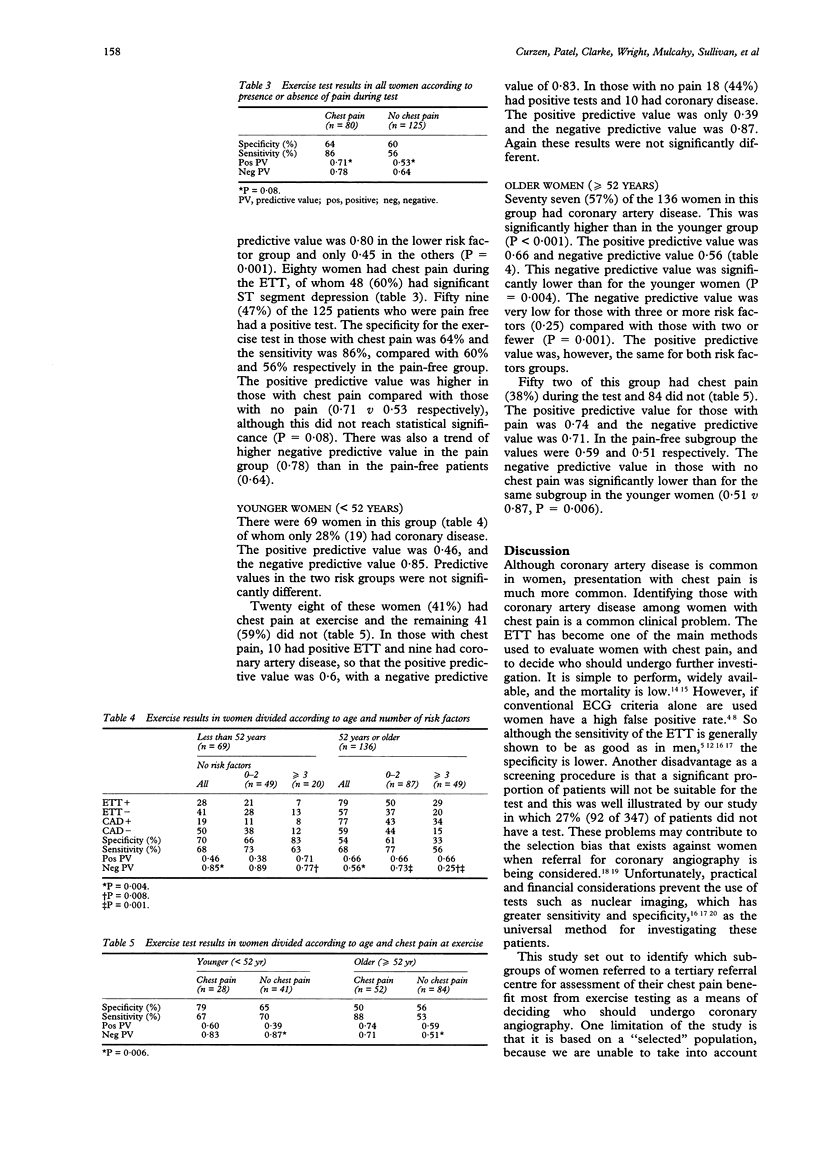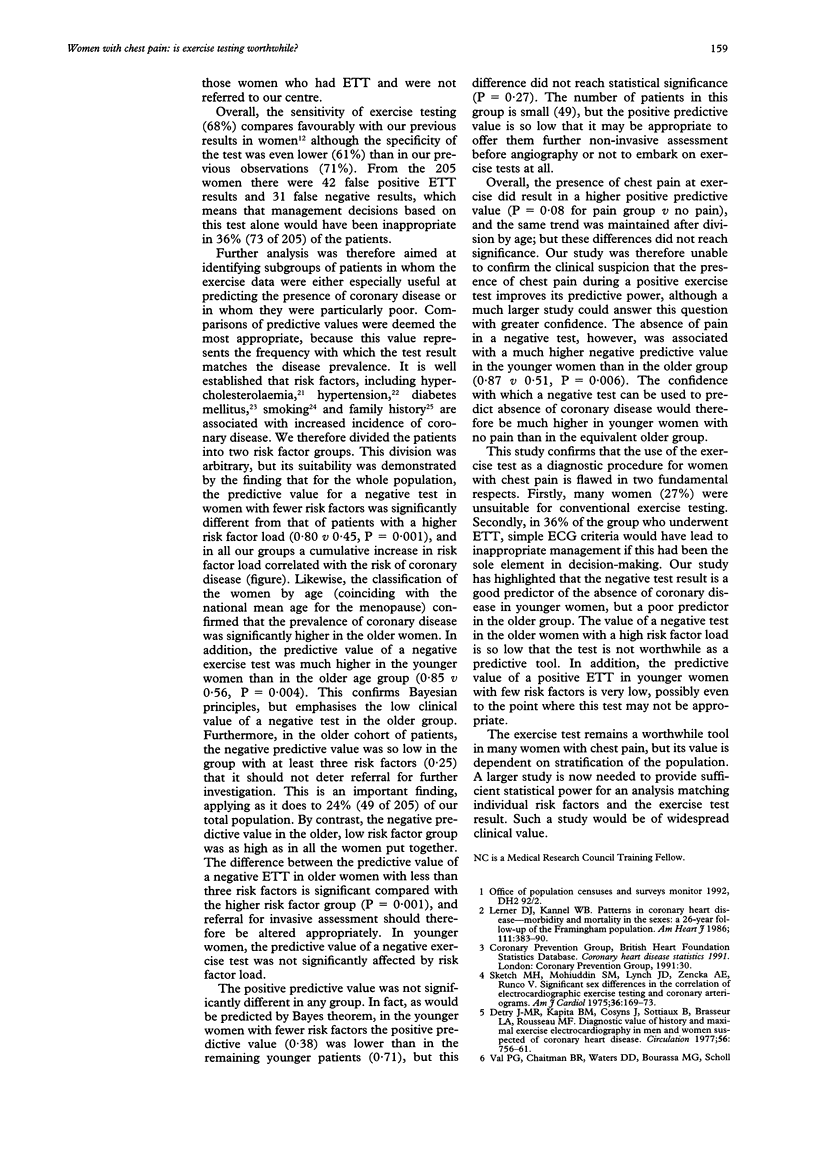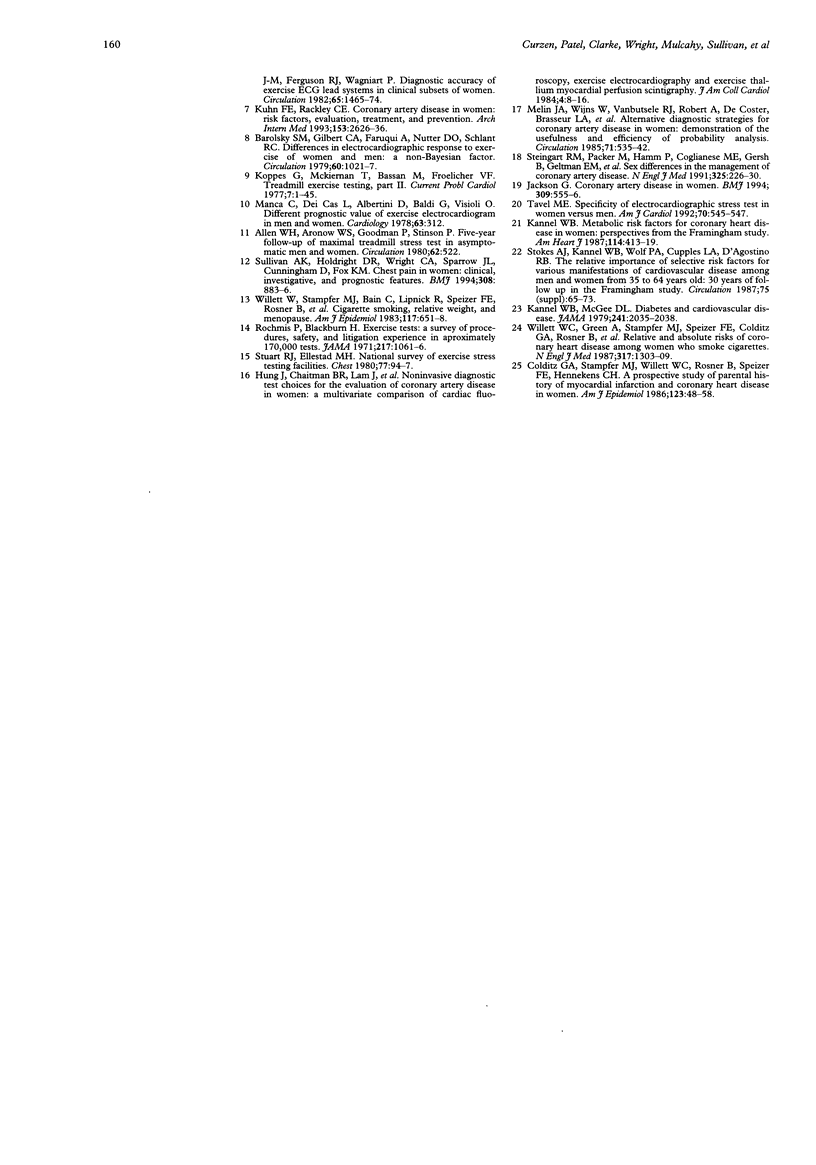Abstract
OBJECTIVE: To determine the diagnostic value of the exercise tolerance test (ETT) in women presenting with chest pain. DESIGN: Prospective study of all women presenting to a centre with chest pain between 1987 and 1993 who were assessed by an ETT and coronary angiography. SETTING: The outpatient clinic of one consultant cardiologist in a tertiary referral centre. PATIENTS: All women referred to this outpatient clinic with chest pain were screened. For inclusion, patients had to perform ETT and undergo coronary angiography. Of the 347 referred during this period, 142 were excluded because they were unable to perform ETT or because of Q waves or other abnormalities on their resting electrocardiogram. RESULTS: Overall the sensitivity of the ETT was 68% and the specificity was 61%, with a positive predictive value of 0.61 and a negative predictive value of 0.68. There were 42 false positive and 31 false negative ETT results (36% of the study group). The predictive value of a negative test was higher in younger women (< 52 years) than in the older group (> or = 52 years) (P = 0.004), but the positive predictive value in the two groups was not significantly different. The predictive value of a negative test was also higher in those with two or fewer risk factors than in those with three or more risk factors (P = 0.001). The negative predictive value for those women above 52 years with three or more risk factors (24% of the study group) was only 0.25. Lack of chest pain during ETT was associated with a higher negative predictive value in the younger group than in the older women (P = 0.006). CONCLUSIONS: In women with chest pain use of the ETT was a misleading predictor of the presence or absence of coronary disease in 36% of these patients. In particular, a negative test in older women with three or more risk factors had a very low predictive value. The inclusion of risk factors and division by age can, however, be used to identify a population at intermediate risk for coronary artery disease in whom the ETT result has the highest diagnostic utility.
Full text
PDF




Selected References
These references are in PubMed. This may not be the complete list of references from this article.
- Allen W. H., Aronow W. S., Goodman P., Stinson P. Five-year follow-up of maximal treadmill stress test in asymptomatic men and women. Circulation. 1980 Sep;62(3):522–527. doi: 10.1161/01.cir.62.3.522. [DOI] [PubMed] [Google Scholar]
- Barolsky S. M., Gilbert C. A., Faruqui A., Nutter D. O., Schlant R. C. Differences in electrocardiographic response to exercise of women and men: a non-Bayesian factor. Circulation. 1979 Nov;60(5):1021–1027. doi: 10.1161/01.cir.60.5.1021. [DOI] [PubMed] [Google Scholar]
- Colditz G. A., Stampfer M. J., Willett W. C., Rosner B., Speizer F. E., Hennekens C. H. A prospective study of parental history of myocardial infarction and coronary heart disease in women. Am J Epidemiol. 1986 Jan;123(1):48–58. doi: 10.1093/oxfordjournals.aje.a114223. [DOI] [PubMed] [Google Scholar]
- Detry J. M., Kapita B. M., Cosyns J., Sottiaux B., Brasseur L. A., Rousseau M. F. Diagnostic value of history and maximal exercise electrocardiography in men and women suspected of coronary heart disease. Circulation. 1977 Nov;56(5):756–761. doi: 10.1161/01.cir.56.5.756. [DOI] [PubMed] [Google Scholar]
- Guiteras P., Chaitman B. R., Waters D. D., Bourassa M. G., Scholl J. M., Ferguson R. J., Wagniart P. Diagnostic accuracy of exercise ECG lead systems in clinical subsets of women. Circulation. 1982 Jun;65(7):1465–1474. doi: 10.1161/01.cir.65.7.1465. [DOI] [PubMed] [Google Scholar]
- Hung J., Chaitman B. R., Lam J., Lesperance J., Dupras G., Fines P., Bourassa M. G. Noninvasive diagnostic test choices for the evaluation of coronary artery disease in women: a multivariate comparison of cardiac fluoroscopy, exercise electrocardiography and exercise thallium myocardial perfusion scintigraphy. J Am Coll Cardiol. 1984 Jul;4(1):8–16. doi: 10.1016/s0735-1097(84)80312-5. [DOI] [PubMed] [Google Scholar]
- Jackson G. Coronary artery disease and women. BMJ. 1994 Sep 3;309(6954):555–557. doi: 10.1136/bmj.309.6954.555. [DOI] [PMC free article] [PubMed] [Google Scholar]
- Kannel W. B., McGee D. L. Diabetes and cardiovascular disease. The Framingham study. JAMA. 1979 May 11;241(19):2035–2038. doi: 10.1001/jama.241.19.2035. [DOI] [PubMed] [Google Scholar]
- Kannel W. B. Metabolic risk factors for coronary heart disease in women: perspective from the Framingham Study. Am Heart J. 1987 Aug;114(2):413–419. doi: 10.1016/0002-8703(87)90511-4. [DOI] [PubMed] [Google Scholar]
- Koppes G., McKiernan T., Bassan M., Froelicher V. F. Treadmill exercise testing, part II. Curr Probl Cardiol. 1977 Dec;2(9):1–45. [PubMed] [Google Scholar]
- Kuhn F. E., Rackley C. E. Coronary artery disease in women. Risk factors, evaluation, treatment, and prevention. Arch Intern Med. 1993 Dec 13;153(23):2626–2636. [PubMed] [Google Scholar]
- Lerner D. J., Kannel W. B. Patterns of coronary heart disease morbidity and mortality in the sexes: a 26-year follow-up of the Framingham population. Am Heart J. 1986 Feb;111(2):383–390. doi: 10.1016/0002-8703(86)90155-9. [DOI] [PubMed] [Google Scholar]
- Manca C., Dei Cas L., Albertini D., Baldi G., Visioli O. Different prognostic value of exercise electrocardiogram in men and women. Cardiology. 1978;63(5):312–319. doi: 10.1159/000169910. [DOI] [PubMed] [Google Scholar]
- Melin J. A., Wijns W., Vanbutsele R. J., Robert A., De Coster P., Brasseur L. A., Beckers C., Detry J. M. Alternative diagnostic strategies for coronary artery disease in women: demonstration of the usefulness and efficiency of probability analysis. Circulation. 1985 Mar;71(3):535–542. doi: 10.1161/01.cir.71.3.535. [DOI] [PubMed] [Google Scholar]
- Rochmis P., Blackburn H. Exercise tests. A survey of procedures, safety, and litigation experience in approximately 170,000 tests. JAMA. 1971 Aug 23;217(8):1061–1066. doi: 10.1001/jama.217.8.1061. [DOI] [PubMed] [Google Scholar]
- Sketch M. H., Mohiuddin S. M., Lynch J. D., Zencka A. E., Runco V. Significant sex differences in the correlation of electrocardiographic exercise testing and coronary arteriograms. Am J Cardiol. 1975 Aug;36(2):169–173. doi: 10.1016/0002-9149(75)90521-4. [DOI] [PubMed] [Google Scholar]
- Steingart R. M., Packer M., Hamm P., Coglianese M. E., Gersh B., Geltman E. M., Sollano J., Katz S., Moyé L., Basta L. L. Sex differences in the management of coronary artery disease. Survival and Ventricular Enlargement Investigators. N Engl J Med. 1991 Jul 25;325(4):226–230. doi: 10.1056/NEJM199107253250402. [DOI] [PubMed] [Google Scholar]
- Stuart R. J., Jr, Ellestad M. H. National survey of exercise stress testing facilities. Chest. 1980 Jan;77(1):94–97. doi: 10.1378/chest.77.1.94. [DOI] [PubMed] [Google Scholar]
- Sullivan A. K., Holdright D. R., Wright C. A., Sparrow J. L., Cunningham D., Fox K. M. Chest pain in women: clinical, investigative, and prognostic features. BMJ. 1994 Apr 2;308(6933):883–886. doi: 10.1136/bmj.308.6933.883. [DOI] [PMC free article] [PubMed] [Google Scholar]
- Tavel M. E. Specificity of electrocardiographic stress test in women versus men. Am J Cardiol. 1992 Aug 15;70(4):545–547. doi: 10.1016/0002-9149(92)91209-m. [DOI] [PubMed] [Google Scholar]
- Willett W. C., Green A., Stampfer M. J., Speizer F. E., Colditz G. A., Rosner B., Monson R. R., Stason W., Hennekens C. H. Relative and absolute excess risks of coronary heart disease among women who smoke cigarettes. N Engl J Med. 1987 Nov 19;317(21):1303–1309. doi: 10.1056/NEJM198711193172102. [DOI] [PubMed] [Google Scholar]
- Willett W., Stampfer M. J., Bain C., Lipnick R., Speizer F. E., Rosner B., Cramer D., Hennekens C. H. Cigarette smoking, relative weight, and menopause. Am J Epidemiol. 1983 Jun;117(6):651–658. doi: 10.1093/oxfordjournals.aje.a113598. [DOI] [PubMed] [Google Scholar]


